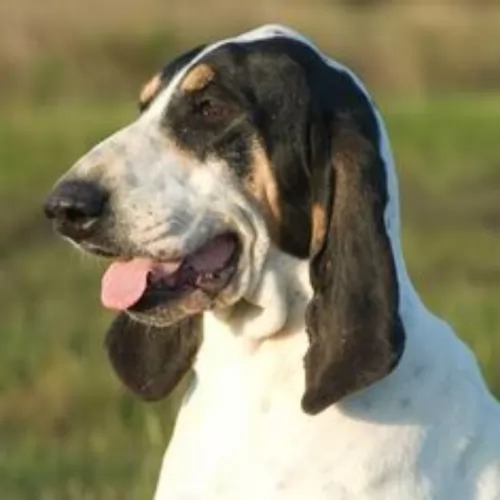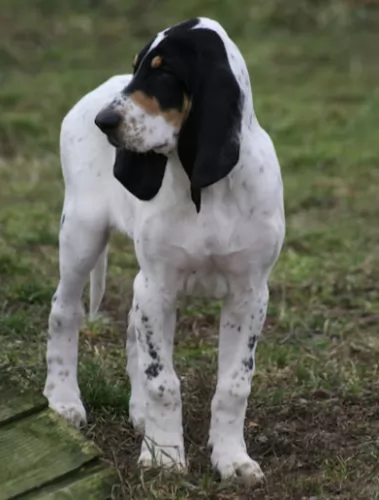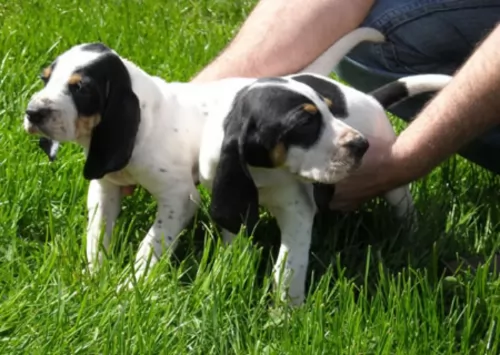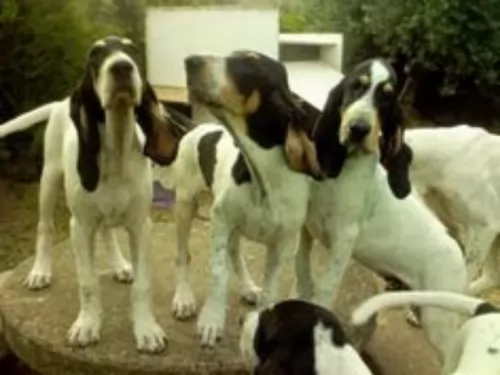 Petzlover
Petzlover Broholmer is originated from Denmark but Grand Gascon Saintongeois is originated from France. Both Broholmer and Grand Gascon Saintongeois are having almost same height. Broholmer may weigh 45 kg / 100 pounds more than Grand Gascon Saintongeois. Both Broholmer and Grand Gascon Saintongeois has almost same life span. Broholmer may have more litter size than Grand Gascon Saintongeois. Broholmer requires Moderate Maintenance. But Grand Gascon Saintongeois requires Low Maintenance
Broholmer is originated from Denmark but Grand Gascon Saintongeois is originated from France. Both Broholmer and Grand Gascon Saintongeois are having almost same height. Broholmer may weigh 45 kg / 100 pounds more than Grand Gascon Saintongeois. Both Broholmer and Grand Gascon Saintongeois has almost same life span. Broholmer may have more litter size than Grand Gascon Saintongeois. Broholmer requires Moderate Maintenance. But Grand Gascon Saintongeois requires Low Maintenance
 This giant dog, the Broholmer, comes from Denmark and falls into the general Molosser type of Mastiff dog. The breed was originally developed by crossing the local German dogs with the English Mastiffs to create what is also known as a Danish Mastiff. The breed is named after an 18th century game-keeper names Sehested of Broholm. This type of dog has been present however since the Middle Ages in Europe. It started out as a stag hunting dog but quickly evolved into a guard dog. They were greatly favored by the wealthy and nobility, including being featured in portraits with King Frederick VII and Countess Danner.
This giant dog, the Broholmer, comes from Denmark and falls into the general Molosser type of Mastiff dog. The breed was originally developed by crossing the local German dogs with the English Mastiffs to create what is also known as a Danish Mastiff. The breed is named after an 18th century game-keeper names Sehested of Broholm. This type of dog has been present however since the Middle Ages in Europe. It started out as a stag hunting dog but quickly evolved into a guard dog. They were greatly favored by the wealthy and nobility, including being featured in portraits with King Frederick VII and Countess Danner.
Like many European dogs, the Broholmer, did not fare well during the second World War. During this time there was little purebred breeding and their numbers decreased almost to the point of extinction. Brought back by a group called “The Society for the Reconstruction of the Broholmer Breed”. With the support of the Danish Kennel Club, they were successful in bring the breed back. They were recognized by both the Federation Cynoloqique Internationale and the Danish Kennel Club. By 2009 they were being imported to the United Kingdom, hoping to get them onto the import lists of the United Kingdom kennel club (UKC).
 Known also as the Virelade, the Grand Gascon Saintongeois hails from the Saintongeois region of France, being a newish addition to the hunting dog breed.
Known also as the Virelade, the Grand Gascon Saintongeois hails from the Saintongeois region of France, being a newish addition to the hunting dog breed.
The Saintongeois hound and the Grand Blue de Gascogne are the ancestors of this scentdog as these two breeds themselves, are exceptional hunters. The Grand Gascon Saintongeois is a large dog and favored by the French nobility for its ability to hunt.
After the French Revolution the popularity of the breed waned. It was Baron Joseph de Carayon-LaTour who tried to revive the Saintongeois Hound. The dogs were mated with the Grand Bleu de Gascogne and were so outstanding that breeding was continued. The breed that was created is the Grand Gascon Saintongeois which we know today.
It was in January 1993 that the Grand Gascon Saintongeois was officially recognized by the United Kennel Club.
 The Broholmer is a very large dog with Mastiff qualities. He is strong, rectangular and powerful in build. He has a massive head and neck with a deep and broad chest. The length of the nose is the same as the length of the skull. He is tall, well built and his thing and hindquarters are powerful. His stance and gait are powerful and intimidating as well. His appearance and size alone account for his guard dog status. However, he is a little smaller than most Mastiffs and he is athletic looking as well.
The Broholmer is a very large dog with Mastiff qualities. He is strong, rectangular and powerful in build. He has a massive head and neck with a deep and broad chest. The length of the nose is the same as the length of the skull. He is tall, well built and his thing and hindquarters are powerful. His stance and gait are powerful and intimidating as well. His appearance and size alone account for his guard dog status. However, he is a little smaller than most Mastiffs and he is athletic looking as well.
The Broholmer is a double coated breed with a short topcoat and a thick undercoat. The color of the Broholmer is yellow or a golden red. Some have white on the feet, tail tip or chest and some have a black mask. Most do not have any mask.
 The Grand Gascon Saintongeois is a large, well built breed of dog that looks strong and robust. His head is strong and covered with loose skin that forms wrinkles around the cheeks. He stands at 61-73cm and weighs 30 to 35kg.
The Grand Gascon Saintongeois is a large, well built breed of dog that looks strong and robust. His head is strong and covered with loose skin that forms wrinkles around the cheeks. He stands at 61-73cm and weighs 30 to 35kg.
He has straight, long legs. He has a short, smooth coat which is white with black patches. Sometimes you'll also find a speckled or ticked pattern. There'll be tan dots over the eyes.
The eyes are brown, the nose black and the long, thin textured ears are low on the dogs head and also well back on the skull. The tail is long.
He is known for his deep voice to voice an opinion. He is a loving, friendly, courageous and affectionate breed with a well balanced temperament, making him a splendid pet. He is also intelligent and so he won't battle at all to learn some rules. Training and socialization will be good for him even though he is such an amicable dog already, but then he just becomes extra obedient.
 The Broholmer is a calm, friendly dog. He is a large dog that thinks he is a lap dog. He wants to be close and snuggle with his people all the time. He is great with kids and other dogs. At the same time, he can be very watchful and protective. Because of this along with his size he needs a strong owner who is clearly the pack leader. He is wary and protective around strangers and can be stubborn if he thinks he is in charge.
The Broholmer is a calm, friendly dog. He is a large dog that thinks he is a lap dog. He wants to be close and snuggle with his people all the time. He is great with kids and other dogs. At the same time, he can be very watchful and protective. Because of this along with his size he needs a strong owner who is clearly the pack leader. He is wary and protective around strangers and can be stubborn if he thinks he is in charge.
 Your Grand Gascon Saintongeois is a true hunting dog breed and valued for his hunting prowess. He has another side to him though and is gentle, loving and calm with his human family.
Your Grand Gascon Saintongeois is a true hunting dog breed and valued for his hunting prowess. He has another side to him though and is gentle, loving and calm with his human family.
He makes a wonderful family companion, getting on well with children as well as pets in the home. He may show a bit of aggression to strangers and this is why training and socialization works so well with him as it helps him behave well around family and strangers.
Training is never a problem as he is an intelligent dog. He is an energetic dog and won't fit well into city life in tiny properties, also because of his tendency to bark when bored. He fits well into country life or large properties.
When you provide your large pet with good food, a warm place to sleep, exercise and plenty of love and attention, the Grand Gascon Saintongeois is going to turn out to be one of the most loyal, affectionate pets you can imagine.
 The Broholmer faces many of the same health issues as other large breeds, even though he is overall a very healthy breed. Some of the types of health issues the Broholmer might deal with include:
The Broholmer faces many of the same health issues as other large breeds, even though he is overall a very healthy breed. Some of the types of health issues the Broholmer might deal with include:
Bloat – caused by eating a large meal too quickly and drinking a lot of water or exercising too soon before or after the large meal.
 Your Grand Gascon Saintongeois is a robust dog, who with good care can reach up to 14 years of age. You're not going to be running to the vet often with this strong looking dog, but even so, there are one to two problems that you'll want to look out for.
Your Grand Gascon Saintongeois is a robust dog, who with good care can reach up to 14 years of age. You're not going to be running to the vet often with this strong looking dog, but even so, there are one to two problems that you'll want to look out for.
Long-eared dogs are more susceptible to canine ear infections. The symptoms of the infection will be dependent on how severe it is. Certainly your dog may experience pain and you'll see him shaking his head and pawing at his ear. If both ears are affected by inflammation, he may even walk in a wobbly fashion and the infection could lead to deafness. It is imperative that he get to the vet as soon as possible.
This is where the ball and socket joint of the hip is malformed. It results in a joint rubbing and grinding. It can lead to loss of function of the hip joints. It is a common skeletal disease in young or old dogs, small or large dogs and in both males and females.
Large dogs are more commonly affected though with hip dysplasia which can see arthritis developing too. Your dog will display decreased activity and difficulty with standing up after lying down. Veterinary intervention will be required.
 Don’t overfeed the Broholmer. Give her about three and three quarters to nine cups of a high quality dry food. Depending on the size of your dog, adjust the amount of food within the guidelines listed here. Feed at least twice a day. Use a large breed dog food.
Don’t overfeed the Broholmer. Give her about three and three quarters to nine cups of a high quality dry food. Depending on the size of your dog, adjust the amount of food within the guidelines listed here. Feed at least twice a day. Use a large breed dog food.
Bloat – when the stomach is twisted and distended. This can cause death is not responded to by a vet immediately.
Eye Issues – Entropion turning inward of eyelids and irritating eye; Ectropium eyelids turn outward, Cataracts and Progressive Retinal Atrophy (PRA) -genetic defects of the retina can cause blindness.
The Broholmer is not an overly active dog but he is big and athletic so has strong exercise needs. A large fenced in back yard is essential or be prepared for several long walks every day. You can play inside games like teaching new tricks or hide and seek but remember this is a big dog. He would love to swim, play frisbee or ball, go hiking or organized activities such as fly ball, agility, rally and obedience. Don’t let your Broholmer over exercise while it is young and still growing. He needs as much mental stimulation as physical exercise.
 These large dogs with their short smooth coats have very little grooming needs. Regular brushing twice a week will remove dead hair and also ensure the good condition of the coat.
These large dogs with their short smooth coats have very little grooming needs. Regular brushing twice a week will remove dead hair and also ensure the good condition of the coat.
He has long ears and these will need to be checked regularly to avoid ear infections. It will be a good idea to learn how to clean the ears and to do it in such a way as to avoid damaging them. Signs of ear infection include redness, discharge, irritation and bad odor.
Following the feeding instructions on the packaging of top quality kibble, provide your Grand Gascon Saintongeois with at least 2 meals a day. To steer away from the monotony of kibble every day, mix in some raw meat from time to time, and also include some cooked brown rice, chicken and vegetables as a tasty treat. Fresh, cool water should always be easily accessible to him.